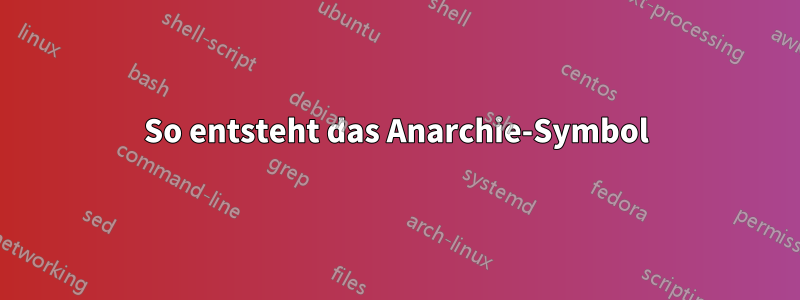
Ich habe mich gefragt, ob es möglich ist, das Anarchiesymbol (das eingekreiste „A“) in LaTeX zu erzeugen. Ich habe versucht, „Latex-Anarchist“ zu googeln und habe nichts als Merchandise und Pornos gefunden, und obwohl ich mich nicht beschwere,Auchwollte das Anarchiesymbol.
Antwort1
Hier sind die Unicode-Codepunkte für anarchische Symbole. Aber das eingekreiste A ist überhaupt nicht angenehm. Vielleicht müssen Sie einige herunterladencoolere Schriftart.... Ich habe diese nur gepostet, damit Sie sehen können, was es gibt und wie man es verwendet.
% arara: lualatex
\documentclass{article}
\usepackage{fontspec}
\usepackage{fontawesome}
\usepackage{booktabs}
\newcommand{\test}[1]{#1 & \setmainfont{#1}\symbol{"24B6} & \setmainfont{#1}\symbol{"2605} & \setmainfont{#1}\symbol{"2691}}
\begin{document}
\begin{tabular}{lccc}\toprule
Font& A & Black Star & Black Flag\\\midrule
\test{Symbola.ttf}\\
\test{Quivira.otf}\\
\test{Xits-regular.otf}\\
\test{Code2000.ttf}\\
\test{DejaVuSans.ttf}\\
Font Awesome&&&\faFlag\\\bottomrule
\end{tabular}
\end{document}

Aus dem Kommentar von Herrn Kormylo:
% arara: pdflatex
\documentclass{article}
\usepackage{marvosym}
\begin{document}
\CircledA
\end{document}

Und schließlich ist hier dieSymbol aus Wikipedia(Ich habe den horizontalen Balken für Sie vergrößert). Da Ihre Frage war, wie manproduzierendas Anarchiesymbol, ich werde das ein wenig erklären. Sie laden eine SVG-Datei von irgendwoher herunter (wie die von Wikipedia bereitgestellte) und öffnen sie in Inkscape. Sie müssen das Add-on installiereninkscape2tikzIn Inkscape wählen Sie
Erweiterungen -> Exportieren -> In TikZ-Pfad exportieren.
Der Rest sollte klar sein.
% arara: pdflatex
\documentclass{article}
\usepackage{tikz}
\begin{document}
\begin{tikzpicture}[y=0.5pt, x=0.5pt,yscale=-1]
\path[cm={{0.0,-1.0,1.0,0.0,(0.0,0.0)}},fill=black,rounded corners=0.0000cm]
(-360.0000,49.3220) rectangle (-296.0000,557.6695);
\path[fill=black] (300.0000,0.0000) .. controls (135.0000,0.0000) and
(0.0000,135.0000) .. (0.0000,300.0000) .. controls (0.0000,465.0000) and
(135.0000,600.0000) .. (300.0000,600.0000) .. controls (465.0000,600.0000) and
(600.0000,465.0000) .. (600.0000,300.0000) .. controls (600.0000,135.0000) and
(465.0000,0.0000) .. (300.0000,0.0000) -- cycle(300.0000,64.0000) .. controls
(431.0000,64.0000) and (536.0000,169.0000) .. (536.0000,300.0000) .. controls
(536.0000,431.0000) and (431.0000,536.0000) .. (300.0000,536.0000) .. controls
(169.0000,536.0000) and (64.0000,431.0000) .. (64.0000,300.0000) .. controls
(64.0000,169.0000) and (169.0000,64.0000) .. (300.0000,64.0000) -- cycle;
\path[cm={{-0.90631,-0.42262,0.42262,-0.90631,(0.0,0.0)}},fill=black,rounded
corners=0.0000cm] (-328.0631,-404.1956) rectangle (-264.0631,95.8044);
\path[cm={{-0.90631,0.42262,-0.42262,-0.90631,(0.0,0.0)}},fill=black,rounded
corners=0.0000cm] (-279.6533,-657.7666) rectangle (-215.6533,-157.7666);
\end{tikzpicture}
\end{document}

Antwort2
Lust auf Anarchie mit TikZ:
\documentclass{article}
\usepackage{tikz}
\usetikzlibrary{decorations.pathmorphing}
\tikzset{mydeco/.style={decoration={random steps,segment length=.6,amplitude=.5},decorate,line cap=round}}
\tikzset{anarchy/.pic={
\draw[ultra thick,mydeco,decorate,red,fill=red](0,0)--(1,.3)--cycle;
\draw[ultra thick,mydeco,red,fill=red](.2,-.3)--(.5,.7)--cycle;
\draw[ultra thick,mydeco,red,fill=red](.5,.7)--(.8,-.3)--cycle;
\draw[red,ultra thick,line cap=round,mydeco](.5,.15) circle(.4);
}}
\begin{document}
Some real \tikz\pic{anarchy};narchy
\end{document}

Auch in einer skalierbareren Art und Weise (nicht skalierbar auf \tiny)
\documentclass{article}
\usepackage{tikz}
\usetikzlibrary{decorations.pathmorphing,positioning}
\tikzset{mydeco/.style={decoration={random steps,segment length=.08em,amplitude=.05em},decorate,line cap=round}}
\tikzset{anarchy/.pic={
\draw[line width=.1em,mydeco,decorate,red,fill=red](0em,0em)--(1.2em,.3em)--cycle;
\draw[line width=.1em,mydeco,red,fill=red](.2em,-.3em)--(.5em,.7em)--cycle;
\draw[line width=.1em,mydeco,red,fill=red](.5em,.7em)--(.8em,-.3em)--cycle;
\draw[line width=.1em,red,line cap=round,mydeco](.5em,.2em) circle(.6em);
}}
\newcommand{\anarchy}{\tikz\pic{anarchy};}
\begin{document}
\scriptsize Some real \anarchy{}narchy
\footnotesize Some real \anarchy{}narchy
\small Some real \anarchy{}narchy
\normalsize Some real \anarchy{}narchy
\large Some real \anarchy{}narchy
\end{document}

Antwort3
Eine Variante mit tikzlängerem Querbalken:
\documentclass{article}
\usepackage{tikz}
\newcommand*{\AnarchySymbol}[1][50pt]{%
\tikz[
x=\dimexpr(#1)\relax,
y=\dimexpr(#1)\relax,
radius=\dimexpr(#1)\relax,
line width=\dimexpr.2\dimexpr(#1)\relax\relax,
]
\draw
circle []
(90:1) -- (235:1)
(90:1) -- (305:1)
(185:1) -- (-5:1)
;%
}
\begin{document}
\AnarchySymbol
\end{document}
Antwort4
Hier ist eine skalierbare TikZ-Variante, die ich im Rahmen eines größeren Projekts gezeichnet habe:
\documentclass[tikz,border=5pt]{standalone}
\usetikzlibrary{through,arrows.meta,calc}
\begin{document}
\tikzset{
anarchy/.pic={%
\draw [line width=.1*#1, {Round Cap[length=.025*#1]}-{Round Cap[length=.025*#1]}, pic actions] (-.5*#1,-.1*#1) -- (.6*#1,.1*#1);
\draw [line width=.1*#1, line join=bevel, {Round Cap[length=.025*#1]}-{Round Cap[length=.025*#1]}, pic actions] (-.25*#1,-.475*#1) -- (0,.5*#1) coordinate (-vertex) -- (.35*#1,-.525*#1);
\node [draw, line width=.1*#1, anchor=center, align=center, pic actions] at (0,0) [circle through={($(-vertex) + (-.15*#1,-.125*#1)$)}] {};
},
}
\begin{tikzpicture}
\pic [red] {anarchy={50pt}};
\end{tikzpicture}
\end{document}

Daher können Sie, wenn Sie möchten, sagen
\begin{tikzpicture}
\path pic [red!50!black] {anarchy={25pt}} -- ++(30pt,0) pic [red] {anarchy=50pt} -- ++(60pt,0) pic [black] {anarchy={75pt}};
\end{tikzpicture}
erhalten




